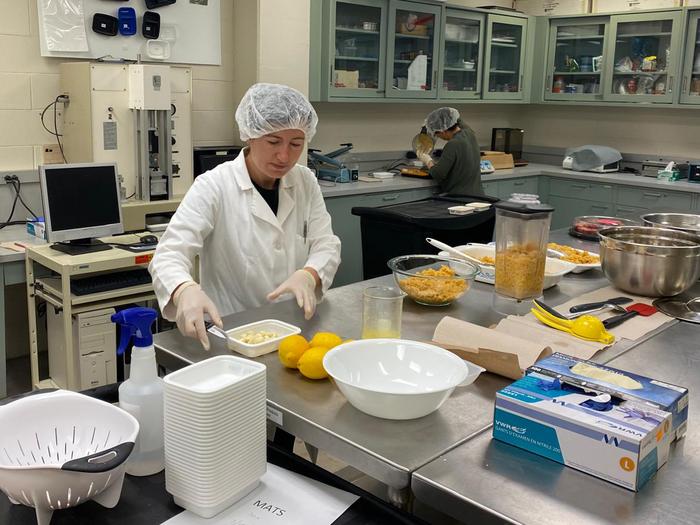Washington State University (WSU) scientists are pioneering a groundbreaking approach in food preservation by developing microwave technologies that enhance the shelf life of hummus without relying on artificial chemical preservatives. Their innovative research, as detailed in a recent article published in the esteemed Journal of Food Process Engineering, highlights the potential of such technologies not only to keep this beloved Middle Eastern dip fresher for longer but also to ensure food safety by eliminating pathogens.
Hummus has surged in popularity across the globe, yet its consumption has been fraught with safety concerns. Between 2000 and 2018, there were reported cases of 20 illness outbreaks linked to hummus in the United States, resulting in 65 hospitalizations and five fatalities. Such alarming figures prompted many commercial brands to turn to chemical preservatives as a means to prolong shelf life and mitigate foodborne illness risks. Even though these chemicals may enhance the product’s longevity, they also raise questions regarding food safety, health impacts, and consumer preferences for more natural ingredients.
The crux of the WSU research revolves around two distinct microwave processing techniques: microwave-assisted pasteurization and microwave-assisted sterilization. Each method employs electromagnetic energy to achieve food safety with varying levels of intensity. The former is a milder treatment that not only preserves the organoleptic qualities of hummus—like taste and texture—but also allows for refrigeration storage for up to a month when unopened. In contrast, the latter technique, while harsher and less flavor-preserving, extends the shelf life significantly, allowing the hummus to remain safe for consumption at room temperature for up to two years if left unopened.
The underlying technology was developed by Juming Tang and his dedicated research team at WSU. They have been focused on using microwave energy to efficiently kill food pathogens while maintaining the nutritional quality of the food. These microwave methodologies permit rapid and uniform heating, thereby minimizing the risk of overcooked or unevenly heated food. Traditional preservation methods, such as canning, often compromise flavor and texture in the quest for safety, but microwave processing presents a solution devoid of such sacrifices.
Shyam Sablani, the lead investigator on the project, expressed enthusiasm about the findings, emphasizing that both processes maintained high quality in terms of storage, texture, and sensory attributes. This was evident in Sablani’s own tasting trials, where he described the final product as “very good,” effectively dispelling any preconceived notions about the potential downsides of using microwave technology in food processing.
Interestingly, WSU’s researchers took an unconventional route by creating a lentil-based version of hummus instead of the traditional chickpea recipe. This switch arose from the insights of visiting researcher Burcu Tenderis, who noted that lentils were commonly utilized in certain regions of Turkey. Lentils, known for their economic advantages and availability in the U.S., provided a unique opportunity to explore other flavor profiles while investigating alternative ingredients that are more sustainable.
In addition to the nutritional and preservation benefits, the team focused on enriching the hummus with vitamin C, a critical nutrient that is often significantly reduced during cooking processes. By measuring the vitamin retention post-treatment, researchers found that the microwave technology managed to retain an impressive 75% of vitamin C in the final product. This outcome points toward the potential for developing healthier snack options that do not compromise on nutritional value.
The next phase of the research aims to gather qualitative feedback by having panels assess their experiences regarding taste, aroma, and overall satisfaction with the product. This step is vital not only for consumer acceptance but also for ensuring that the final product aligns with market preferences and health standards.
This project was part of the Soil to Society program, which aims to enhance public access to nutritious foods derived from grains and legumes. The collaboration has allowed for crucial advances in the research, though Sablani now seeks industry partners to assist in scaling the production for consumer markets. If progress in commercialization is realized, it could mark a significant achievement in the food industry by bridging the gap between nutrition, safety, and taste.
While the commercialization process will likely require several years of development and marketing, the excitement surrounding this research is infectious. Ensuring that foods remain safe and shelf-stable while providing essential nutrients is more important than ever, especially in a world where food security is a growing concern.
The potential implications of this research extend far beyond the humble chickpea and lentil hummus. By pioneering microwave technologies that resonate with today’s health-conscious consumers, WSU is setting a precedent for how the food industry can innovate for enhanced safety, improved quality, and greater consumer appeal in the realm of perishable items.
The diligent work of WSU researchers represents a potential turning point in food processing, enabling the evolution of traditional recipes into modern, health-oriented products. The shift towards natural food preservation methods may not only herald a healthier future for consumers but also drive forward-thinking innovations in food technology.
In essence, the drive to improve food safety while enriching nutritional quality is a testament to the relentless pursuit of better food practices. As WSU continues to navigate this intersection of science, health, and culinary tradition, it opens a world of possibilities for future explorations and innovations.
By employing microwave technology in food preservation, this research project may very well redefine how we think about food safety and shelf stability, encouraging a movement toward healthier, preservative-free options available for all.
Subject of Research: Development of Vitamin C-Enriched Lentil Hummus
Article Title: Development of Vitamin C-Enriched Lentil Hummus With Innovative Microwave Technologies
News Publication Date: 12-Apr-2025
Web References: Journal of Food Process Engineering
References: Microwave Food Preservation Research
Image Credits: Photo courtesy of Burcu Tenderis
Keywords
Hummus, Microwave Technology, Food Safety, Shelf Life, Natural Preservation, Nutritional Value, Lentils, Vitamin C, Food Engineering, Washington State University




